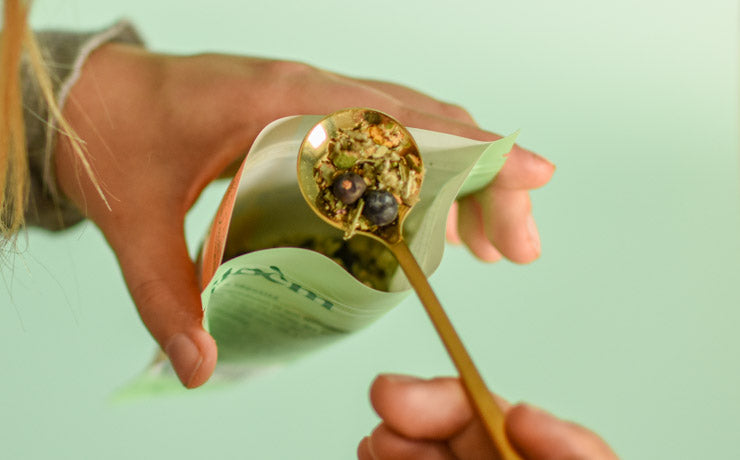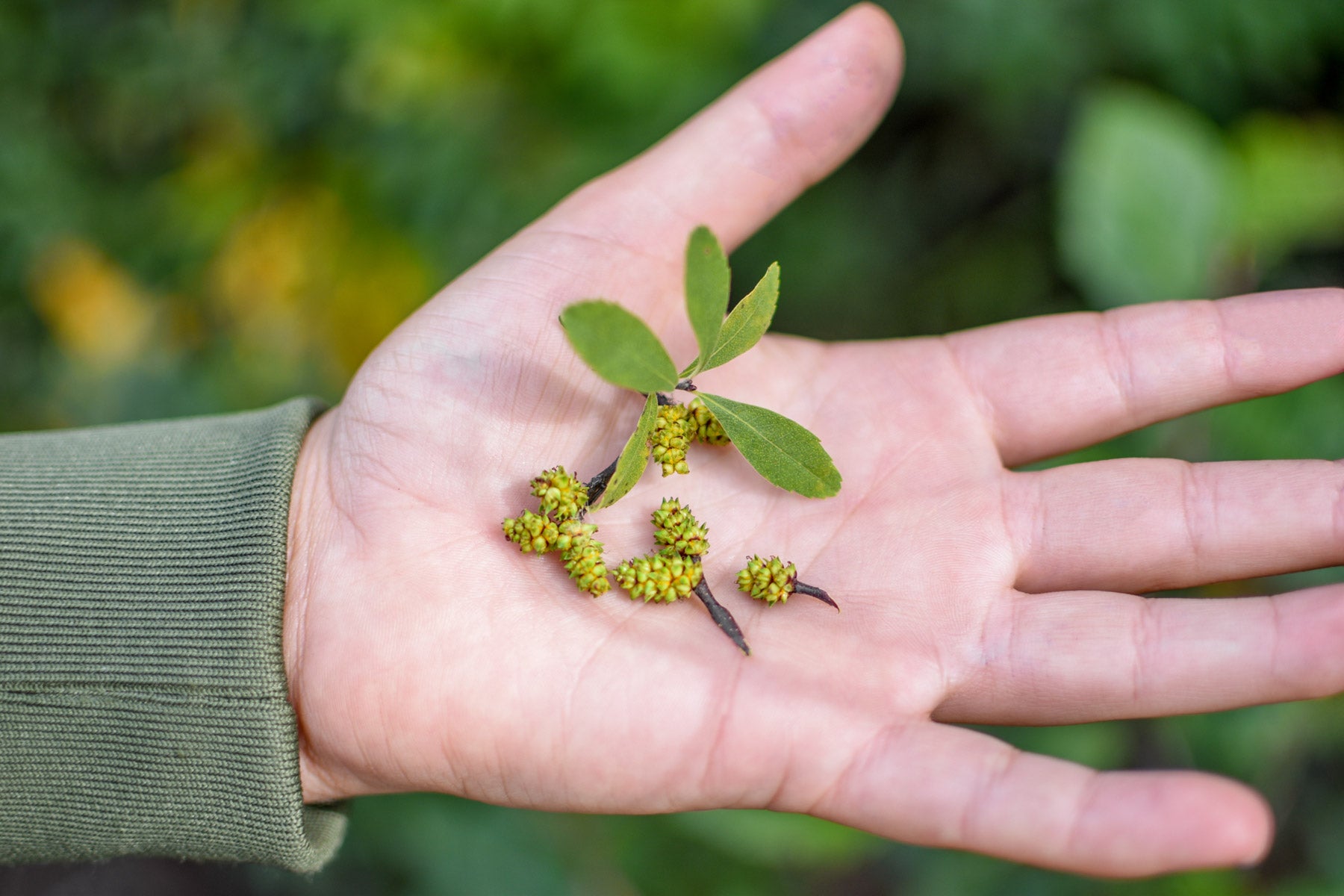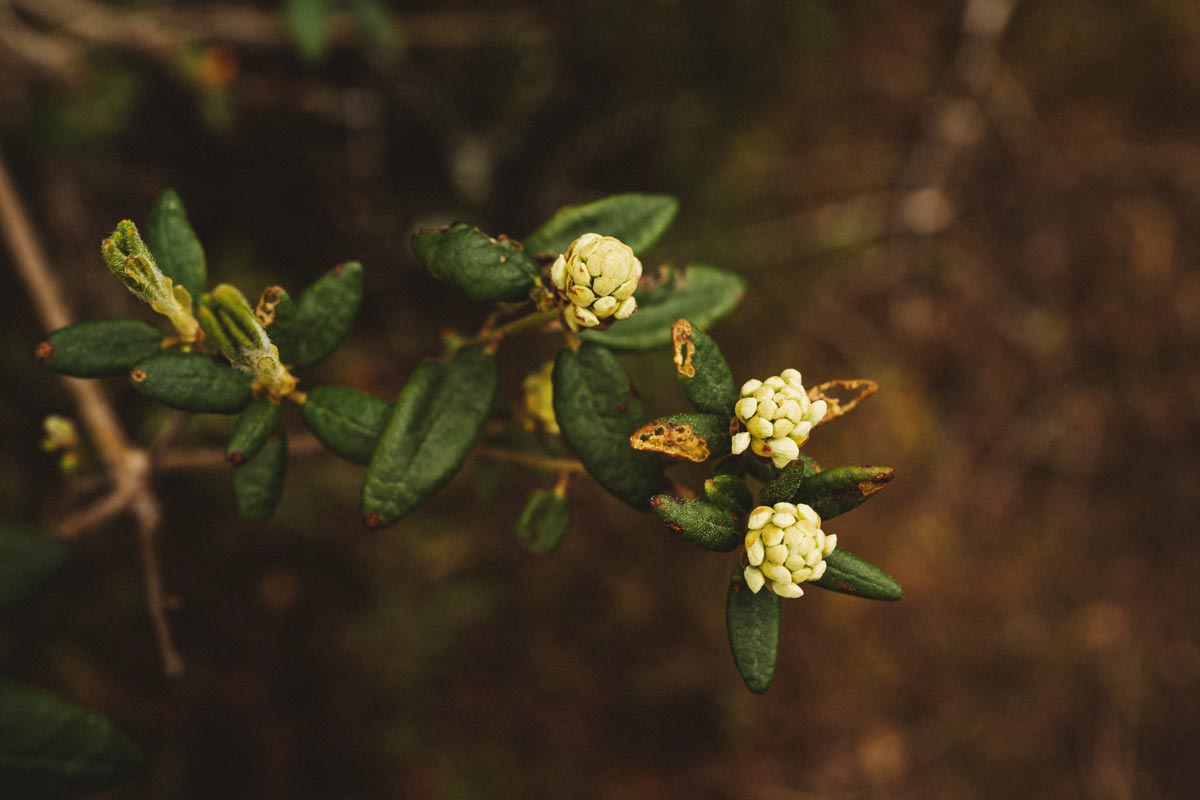
Wintergreen: A Hidden Treasure of the Boreal Forest
Imagine a walk in the forest, the fresh air caressing your face, the scent of pines and firs enveloping you. Suddenly, you notice a carpet of small dark green leaves, dotted with bright red berries. You have just encountered wintergreen, more commonly known as wintergreen. This discreet plant, emblematic of the boreal forest, conceals many secrets and unsuspected benefits. Let us guide you through its fascinating world.

What is wintergreen ?
Botanical name and characteristics of the plant
Wintergreen , scientifically known as Gaultheria procumbens , is a small evergreen shrub of the Ericaceae family. It is distinguished by its oval, leathery, shiny leaves, of a deep green that persists even under snow. In summer, delicate white bell-shaped flowers appear, followed in autumn by small, juicy, edible red berries.
These berries, which have a sweet yet tart taste, are reminiscent of peppermint and are enjoyed by both humans and wildlife. They are an important food source for many birds and small mammals, contributing to the biodiversity of the boreal forest.
Natural habitat and geographical distribution
Wintergreen is a native plant of North America, found primarily in the boreal and temperate regions of Canada and the United States. It is particularly fond of cool, shady undergrowth in coniferous forests, where it often forms vast green carpets.
In Quebec, it is frequently found in mixed forests and peat bogs, particularly in the Mauricie, Saguenay-Lac-Saint-Jean and Gaspésie regions. Its presence is an indicator of the health of the forest ecosystem, as it prefers acidic, well-drained soils rich in organic matter.
Active components and their properties
Wintergreen owes its characteristic aroma and many therapeutic virtues to an organic compound called methyl salicylate. Present in large quantities in the leaves and berries of the plant, this compound has remarkable anti-inflammatory, analgesic and antiseptic properties.
Methyl salicylate acts in a similar way to aspirin, inhibiting the production of prostaglandins, molecules involved in inflammatory processes and pain. This is why wintergreen is traditionally used to relieve muscle pain, headaches and rheumatism.
In addition, methyl salicylate has decongestant and expectorant properties, making it a valuable ally in cases of colds, sinusitis or bronchitis. It helps to thin bronchial secretions and facilitate their expulsion, thus promoting better breathing.

Traditional uses of wintergreen tea
Use by indigenous peoples of North America
The indigenous peoples of North America, connoisseurs of medicinal plants, had used wintergreen for centuries to treat a multitude of ailments. The leaves, rich in methyl salicylate, were infused to prepare a tea with analgesic and anti-inflammatory properties, effective against joint pain, headaches and fevers.
The leaves were also crushed and applied as a poultice to sprains, strains, and insect bites to reduce inflammation and soothe pain. Some tribes even used the smoke from the burned leaves to relieve nasal congestion and sore throats.
Common Home Remedies
The traditional uses of wintergreen have continued to this day, and it is still found in many home remedies. Wintergreen leaf infusion is still valued for its soothing and anti-inflammatory properties, and is often consumed for colds, flu, or muscle aches.
A massage oil can also be prepared by macerating wintergreen leaves in vegetable oil. This oil, applied by massage to painful areas, provides rapid and effective relief thanks to the penetration of methyl salicylate through the skin.
Various therapeutic applications
In addition to its traditional uses, wintergreen has also found its place in modern medicine. Scientific studies have confirmed its anti-inflammatory and analgesic properties, and it is sometimes recommended in addition to other treatments to relieve joint pain related to osteoarthritis or rheumatism.
Wintergreen is also used in herbal medicine to treat digestive disorders, such as bloating, flatulence and intestinal spasms. Its antiseptic properties make it a valuable ally for preventing infections and promoting wound healing.
Health Benefits of Wintergreen Tea

Anti-inflammatory and analgesic properties
As we have seen previously, wintergreen is a powerful natural anti-inflammatory and analgesic, thanks to its high content of methyl salicylate. This substance works by blocking the production of prostaglandins, molecules responsible for inflammation and pain.
Thus, wintergreen can be used to relieve various types of pain, whether of muscular, joint or nervous origin. It is particularly effective in cases of headaches, menstrual pain, dental pain and pain related to rheumatism.
Beneficial effects on the respiratory system
Wintergreen is also an excellent ally for the respiratory system. Its decongestant and expectorant properties help clear the airways in cases of colds, sinusitis or bronchitis.
The methyl salicylate in wintergreen loosens mucus and makes it easier to expel, allowing you to breathe better. In addition, its antiseptic properties help fight respiratory infections and soothe throat irritations.
Support for digestion
Wintergreen can also help improve digestion and relieve some gastrointestinal disorders. Its carminative properties help reduce bloating and flatulence, while its antispasmodic properties soothe cramps and intestinal spasms.
In addition, wintergreen stimulates the secretion of digestive juices, thus promoting better digestion of food. It can be useful in cases of slow digestion, lack of appetite or nausea.
Wintergreen in Food and Beverages

Popular flavor in the food industry
Wintergreen tea doesn't just delight our senses during walks in the forest or heal us with its medicinal properties. Its unique aroma, at once fresh, minty and slightly spicy, has conquered the world of food. It has become a prized ingredient in the food industry, bringing a distinctive touch to many products.
Thus, you will find the characteristic flavor of wintergreen in a variety of everyday products: chewing gum, candy, toothpaste, syrups, and even some soft drinks. Its ability to freshen breath and stimulate taste buds makes it a flavor of choice for oral hygiene products and confectionery.
Wintergreen and Root Beer
If you're a root beer fan, you might be surprised to learn that its distinctive flavor comes largely from wintergreen! In fact, the essential oil extracted from the leaves of this plant is one of the key ingredients in this iconic North American beverage.
It is methyl salicylate, abundant in wintergreen, that gives root beer its distinctive, slightly spicy, minty flavor. This surprising pairing of a wild plant and a popular beverage is a testament to the versatility and universal appeal of wintergreen.
Other creative culinary uses
Beyond these commercial applications, wintergreen can also be used creatively in cooking. Its fresh or dried leaves can be added to salads, desserts, marinades or sauces, to bring a fresh and aromatic note to your dishes.
Wintergreen berries, on the other hand, can be eaten fresh, dried, or made into jams, jellies, and syrups. Their sweet, slightly tart flavor pairs wonderfully with red fruits and citrus fruits.
If you would like to further explore the culinary possibilities of wintergreen, feel free to check out our selection of infusions and boreal plant-based products on our website. You will discover original and tasty creations that highlight the treasures of the Quebec forest.

Growing Wintergreen in Your Garden
Tips for growing and maintenance
If you have fallen in love with wintergreen, why not invite it into your garden? This perennial plant, undemanding and resistant, adapts easily to different environments and will bring a touch of wild nature to your outdoor space.
Wintergreen prefers acidic, well-drained soils rich in organic matter. It also appreciates shaded or semi-shaded locations, similar to its natural forest habitat. Once well established, it requires little maintenance and is resistant to diseases and pests.
Choice of location and soil
To ensure your wintergreen grows well, choose a location that is sheltered from direct sunlight, preferably under trees or shrubs. The soil should be slightly acidic, with a pH between 4.5 and 6. If your soil is too alkaline, you can amend it by adding sphagnum peat moss or leaf compost.
Before planting your wintergreen, make sure the soil is well-drained. If water sits, the roots may rot. You can improve drainage by adding sand or perlite to the soil.
Multiplication and propagation
Wintergreen spreads naturally by stolons, horizontal stems that root in contact with the soil. You can therefore easily propagate your plant by taking sections of rooted stolons and replanting them elsewhere in your garden.
You can also sow wintergreen seeds, but this method is more time-consuming and less reliable. The seeds require cold stratification to germinate, which is a period of several weeks in the refrigerator before sowing.
Harvesting and preparing wintergreen tea

When and how to harvest the leaves
Wintergreen leaves can be harvested throughout the year, but their methyl salicylate concentration is highest in spring and summer, when they are in bloom. To preserve the plant, it is recommended to only collect a few leaves per plant, taking care not to damage the stems.
To harvest the leaves, use clean, sharp pruning shears or scissors. Cut the leaves at the base of the stem, leaving a small portion of the stem attached to the leaf.
Drying and preservation methods
Once harvested, wintergreen leaves can be used fresh or dried. To dry, spread them out in a single layer on a tray or rack in a dry, ventilated area away from direct sunlight. Turn them regularly to ensure even drying.
The leaves are dry when they become brittle to the touch. You can then store them in an airtight container, away from light and humidity, for several months.
Preparation of a traditional infusion
To enjoy the benefits of wintergreen, there's nothing like a traditional infusion. Here's how to prepare it:
- Bring water to a boil.
- Add one tablespoon of fresh or dried wintergreen leaves per cup of water. Break the leaves to release the flavor!
- Let it steep for more than 10 minutes.
- Strain and enjoy!
You can add honey or lemon to sweeten the taste of the infusion, or mix it with other medicinal plants, such as peppermint or chamomile, to create personalized blends.
Untangling the Confusion: Peppermint vs. Wintergreen
Botanical differences and origins
Peppermint ( Mentha × piperita ) and wintergreen ( Gaultheria procumbens ) are two distinct plants, belonging to different botanical families. Peppermint is a herbaceous plant in the Lamiaceae family, while wintergreen is a shrub in the Ericaceae family.
Peppermint is native to Europe and Asia, while wintergreen is native to North America. Their natural habitats are also different: peppermint prefers moist, sunny soils, while wintergreen thrives in cool, shady undergrowth.
Aromatic similarities and distinctions

Although their aromas may seem similar at first glance, peppermint and wintergreen have distinct nuances. Peppermint has a fresh, tangy scent with a slightly sweet undertone. Wintergreen, on the other hand, offers a more complex aroma that is fresh, minty, and slightly spicy, sometimes reminiscent of root beer.
These aromatic differences are explained by the chemical composition of their essential oils. Peppermint contains mainly menthol, while wintergreen is rich in methyl salicylate. These two compounds, although chemically close, give the plants distinct properties and aromas.
Specific uses of each plant
Peppermint and wintergreen are both used in herbal medicine and aromatherapy, but their applications differ slightly. Peppermint is primarily used for its digestive, antispasmodic, and stimulant properties. It is often recommended for nausea, bloating, headaches, or fatigue.
Wintergreen, on the other hand, is more appreciated for its anti-inflammatory, analgesic and decongestant properties. It is often used to relieve muscle and joint pain, headaches, colds and respiratory infections.
FAQ: Your questions about wintergreen tea
Can you eat the leaves?
Yes, wintergreen leaves are edible, but they are best consumed in moderation due to their methyl salicylate content. You can add them to salads, desserts, or use them to flavor your dishes.
Are the berries edible?
Yes, wintergreen berries are edible and have a pleasantly sweet and minty taste. You can eat them fresh, dried or use them to make jams, jellies or syrups. They are an excellent source of vitamins and antioxidants.
Are there any allergies to wintergreen?
Although rare, it is possible to be allergic to wintergreen. People who are allergic to aspirin or other salicylates should be especially careful, as wintergreen contains methyl salicylate, a substance related to aspirin.
Symptoms of a wintergreen allergy may include itching, redness, rash, difficulty breathing, or swelling of the face or throat. If you experience any of these symptoms after consuming or using wintergreen, seek medical attention immediately.
Wintergreen tea, an invitation to discovery

Wintergreen, this discreet but powerful plant, embodies the very essence of the boreal forest. From its ancestral origins to its modern uses, it reminds us of the richness and diversity of the nature that surrounds us. Whether for its health benefits, its unique aroma or simply for the pleasure of picking it in the forest, wintergreen deserves to be rediscovered and appreciated at its true value.
Summary of benefits and precautions
In summary, wintergreen is a true treasure of nature, offering a multitude of health benefits:
- Anti-inflammatory and analgesic : it relieves muscle and joint pain and headaches
- Decongestant and expectorant : it helps clear the airways in case of colds or sinusitis
- Digestive : it promotes digestion and soothes gastrointestinal disorders
- Antiseptic : it helps prevent infections and promote healing
However, it is important to use it in moderation and to follow certain precautions, especially in case of pregnancy, breastfeeding, or medication. It is also essential to protect your pets from this plant, which can be toxic to them.
Call to explore boreal flavors
Wintergreen is just one example of the riches the boreal forest has to offer. Many other plants, with unique flavors and virtues, are waiting to be discovered and appreciated. So why not indulge in a taste and sensory adventure in the heart of Quebec's nature?
Invitation to discover Floèm infusions

At Floèm, we are passionate about boreal flora and its hidden treasures. We have created a range of unique infusions , made from wild plants hand-picked in the forests of Quebec. Our infusions, such as our Labrador Tea , invite you on a sensory journey to the heart of nature, while offering you the benefits of traditional medicinal plants.
We invite you to explore our collection of infusions and discover the authentic flavors and captivating aromas of the boreal forest. Let yourself be seduced by the magic of wild plants and treat yourself to a moment of relaxation and well-being, in harmony with nature.
Don't wait any longer, come and discover the Floèm universe and let yourself be transported by the flavors of the boreal forest!












2 comments
Bonjour Celine, bien sûr, voici une recette simple pour faire de la gelée au thé des bois :
Ingrédients:
4 tasses de feuilles de thé des bois fraîchement cueillies
4 tasses d’eau
1 sachet de pectine liquide
3 tasses de sucre
Instructions:
Infusion: Rincer les feuilles de thé des bois à l’eau froide. Dans une grande casserole, porter l’eau à ébullition. Retirer du feu et ajouter les feuilles de thé des bois. Laisser infuser pendant 15 minutes.
Filtration: Filtrer l’infusion à travers un tamis fin ou une étamine, en pressant bien sur les feuilles pour extraire tout le liquide. Mesurer le liquide et ajouter de l’eau si nécessaire pour obtenir 3 tasses de liquide.
Cuisson: Verser le liquide dans une grande casserole et ajouter la pectine liquide. Porter à ébullition à feu vif, en remuant constamment.
Sucre: Ajouter le sucre en une seule fois et porter de nouveau à ébullition, en remuant constamment. Laisser bouillir pendant 1 minute.
Mise en pot: Retirer du feu et écumer la mousse qui se forme à la surface. Verser la gelée chaude dans des pots stérilisés, en laissant un espace de 1/4 de pouce en haut. Essuyer les bords des pots et fermer hermétiquement.
Stérilisation: Traiter les pots dans un bain-marie bouillant pendant 10 minutes. Retirer les pots et laisser refroidir complètement.
Conseils:
Pour une gelée plus ferme, utiliser 4 tasses de sucre au lieu de 3.
Pour vérifier si la gelée est prête, déposer une cuillère de gelée sur une assiette froide. Si elle se fige rapidement, elle est prête.
Vous pouvez ajouter une cuillère à soupe de jus de citron à la gelée pour une saveur plus acidulée.
Conservation:
La gelée au thé des bois se conserve plusieurs mois dans un endroit frais et sombre. Une fois ouverte, conserver au réfrigérateur.
Dégustation:
La gelée au thé des bois est délicieuse sur des rôties, des crêpes, des gaufres, ou comme accompagnement de viandes et de fromages.
J’espère que cette recette vous plaira! N’hésitez pas à me poser d’autres questions si besoin.
Floèm
Bonjour,
Auriez-vous svp, une recette de Gelée au thé des bois ?
Merci
Céline
Leave a comment
This site is protected by hCaptcha and the hCaptcha Privacy Policy and Terms of Service apply.